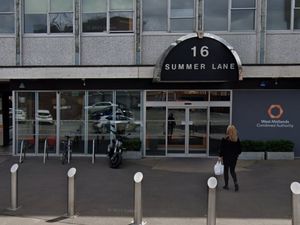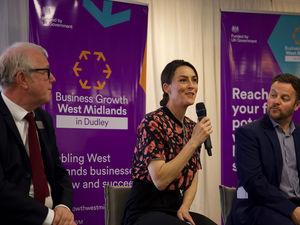Unemployment rises in West Midlands but is unchanged nationally
The West Midlands has seen a rise in unemployment in the three months to December.
Latest figures from the Office of National Statistics showed there were 131,000 people out of work – up 4,000 on the September to November figures.
The unemployment rate for the region now stands at 4.4 per cent.
The rate of UK unemployment in the three months to December was unchanged from the previous three months.
Figures for those claiming unemployment benefits, including Universal Credit, fell in the West Midlands by 1,120 in January from December to 176, 215 – 4.8 per cent of the working population.
Wolverhampton saw the number of claimants fall by 120 to 12,295 (7.4 per cent of the working population) and Sandwell also saw claimant figures fall by 200 to 13,465 (6.2 per cent).
Dudley was up 15 to 9,280 (4.7 per cent) and Walsall rose by 100 to 9,610 (5.5 per cent of the working population). In Birmingham, claimant figures stood at 60,780 .
Overall, in Staffordshire, the number of claimants rose slightly, by 60, to 14,700 (2.8 per cent of the working population).
Stafford, figures were down by 45 to 2,040 (2.5 per cent of the working population).
Claimants in Lichfield were also down by 20 to 1,575 (2.5 per cent) but there was an increase in south Staffordshire of 45 to 1,770 (2.7 per cent).
In Cannock Chase, there was an increase of 25 claimants, moving it up to 2,070 (3.3 per cent).
In the Wyre Forest, including Kidderminster, the number of claimants was down 20 at 1,930 (3.3 per cent).
Karen Townsley, customer service leader for Jobcentre Plus in Walsall, said efforts in the Black Country involving work coaches were being stepped up with the over-50s – and those who had been out of work due to ill health – with the aim of increasing the workforce.
Jobcentre Plus is working with the NHS and Exemplar Health Care to fill shortages of care workers in the region. It is also working with National Express to find new bus drivers.
The Office for National Statistics (ONS) said the rate of UK unemployment was 3.7 per cent in the three months to December, the same rate that was recorded in the three months to November.
However, it had edged higher than the previous calendar quarter, with the unemployment rate standing at 3.6 per cent in the three months to September.
The data showed that regular pay growth was 6.7 per cent in the three months, the strongest growth rate seen outside the pandemic, the ONS said.
In a sign that the labour market is slowing, the estimated number of vacancies fell by 76,000, the seventh consecutive fall.
This reflects economic pressures and uncertainty still leading firms to hold back on recruitment, the ONS said.
There were also signs of a wave of people returning to the workplace amid the cost-of-living crisis as the data showed a record high net flow of people moving from economic inactivity and into employment.
This was driven largely by younger people and students, and older people aged 50 to 64, for whom inactivity dropped the most.
Therefore, the extremely tight labour market seen after the pandemic, where there were record numbers of job vacancies and severe staff shortages, has begun to ease up, the ONS suggested.
The ONS’s director of economic statistics, Darren Morgan, said: “The last quarter of 2022 saw fewer people remaining outside the labour market altogether, with some moving straight back into a job and others starting to seek work again.
“This meant that although employment rose again, unemployment edged up also.
“Although there is still a large gap between earnings growth in the public and private sectors, this narrowed slightly in the latest period. Overall, pay, though, continues to be outstripped by rising prices.
“Though still at historically very high levels, job vacancies have dropped again, with a particularly sharp fall from the smallest employers.
“The number of working days lost to strikes rose again sharply in December. Transport and communications remained the most heavily affected area, but this month there was also a large contribution from the health sector.”
Minister for Employment Guy Opperman said: “It’s encouraging to see that more people are moving into work, as we know that being in employment is the best way to deliver financial security, skills and confidence.
“We’ve also made huge progress for everyone looking to boost their earnings or land a new role, with the employment rate increasing and more people joining payrolls.
“Growing the economy is one of our top five priorities which will deliver more high quality jobs, boosting everyone’s prospects and prosperity.”
Jane Gratton, head of people policy at the British Chambers of Commerce, said: “Businesses are crying out for people to fill job vacancies at all skill levels, and this must be the number one focus for government if it’s serious about economic growth.
“There are still a huge number of vacancies, currently sitting at 1.134 million, and this is stopping firms in their tracks. It means they are struggling to meet the orders on their books, and it puts any plans for growth far out of reach.
"It is also ramping up pressure on wages, currently at the highest rates seen in the private sector outside of the pandemic. This has been identified by the Bank of England as a factor in its decisions to raise interest rates to tame inflation.
“Government plans to get the UK’s untapped labour force into employment are a step in the right direction, but we need to see more action to address the barriers that are holding people back. "
Matthew Percival, Confederation of British Industry director for people and skills, said:
"While there are tentative signs that more people are looking to get back into work, there are still very high vacancies and businesses are having difficulty filling them.
“The upcoming Budget is the opportune moment for the Government to now make some real progress on the workforce shortages the economy is struggling with. That requires action on a number of fronts, including expanding childcare, updating the Shortage Occupations List and widening the scope of employer health support as a non-taxable benefit to prevent and treat some of the key drivers of long-term absence.
“And finally, by launching a two-year pilot of turning the failing Apprenticeship Levy into a more flexible Skills Challenge Fund businesses would be in a better position to help jobseekers of all ages learn new skills.”
Kate Shoesmith, deputy chief executive of the Recruitment and Employment Confederation, said: “This is a very steady set of job figures and further evidence of the UK’s robust labour market – which is good news, given the global levels of uncertainty right now. But when both productivity and economic inactivity are not improving from pre-pandemic levels, we must focus on the fixes.
“Recruiters and business groups still warn that labour shortages are holding back economic growth. Only by working together can employers and government hope to draw more people, from a range of backgrounds, into the labour force."





